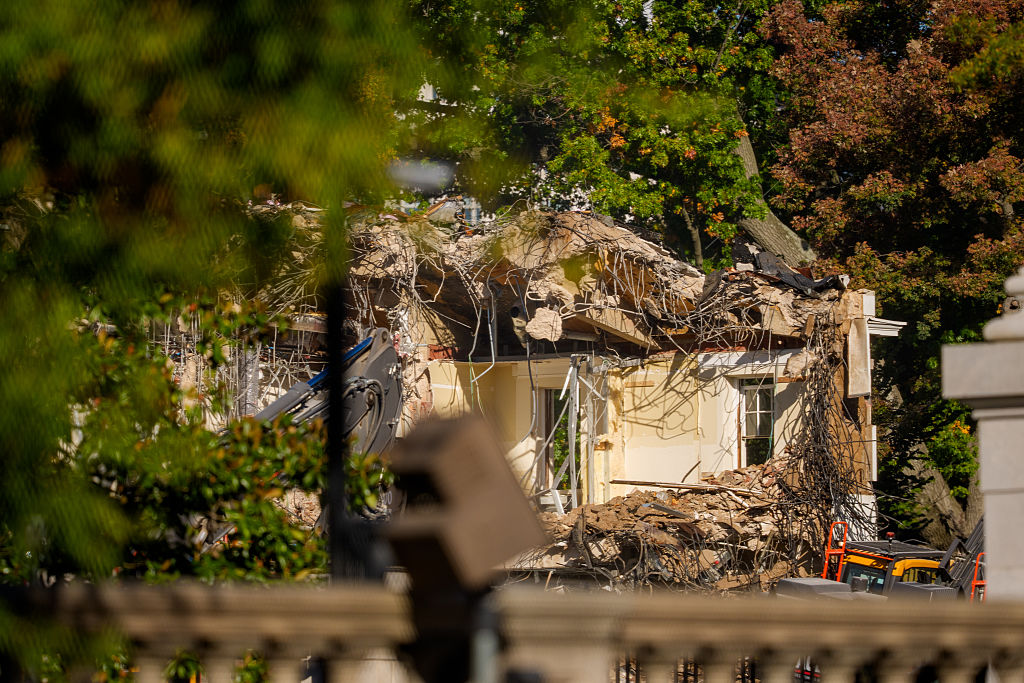This article is part of The D.C. Brief, TIME’s politics newsletter. Sign up here to get stories like this sent to your inbox.
First came the gilding of the Oval Office. Then came the flagpoles, both massive. Then the stone tile and food-court umbrellas over the Rose Garden. And then gold accents joined the Cabinet Room. And the art got swapped out, even putting Barack Obama and George W. Bush out of public view. The tile in the Lincoln Bedroom’s bathroom got exchanged for marble. The same happened with the breezeway leading into the Rose Garden. And the West Colonnade got its own upgrade, complete with an insult for former President Joe Biden.
[time-brightcove not-tgx=”true”]
And now come the bulldozers, the water cannons, and the construction walls to block views of the massive demolition of the White House’s East Wing, the latest manifestation of President Donald Trump’s effort to leave his mark on one of America’s most iconic buildings. By the weekend, the East Wing will be rubble, the latest D.C. institution to be smashed by Trumpism.
Since 1942, when a second floor was added to the East Wing, it has been one of the most traveled parts of the world-famous White House campus. Almost all visitors came through it. Whereas the West Wing was a hard political space, the East Wing was a softer, apolitical space. It had Jacky O’s gardens and a family movie theater down the hall. For most state dinners, the hall there was the photo-op red carpet.
The tear-down of the East Wing removes offices used by the First Lady’s staff, the events team that handles events, and the military office, as well as a key entrance where the public arrives for tours and receptions. Where guests from around the world previously enjoyed state dinners now stands piles of debris.
YouGov polling conducted Tuesday found 53% of Americans opposed the tear-down, and just 23% support it. This was an undertaking that almost no one was asking for.
Trump is determined to ensure he cannot be as easily erased from history as a statue of a Confederate leader. He wants a cornerstone of the symbol of the nation to be of his making. To get there, he plans to overshadow the existing White House with an immense cavern that will dwarf the existing complex. The new ballroom is projected to be 90,000 square feet. By comparison, the main building of the White House itself is 55,000 square feet.
The remaking of the White House is a massive change to the canvas where global affairs are set into motion, where Americans have had collective moments of celebration and heartbreak, where history is made with every utterance. Whereas Trump’s predecessors sided with understated symbols of power, Trump is giving his temporary home the Full Versailles.
The $250 million behemoth is set to host 999 people and is said to have been funded entirely with private donations. On Wednesday, Trump upped the estimated cost to $300 million.
The White House and Treasury Department told staffers not to share photos of the mayhem without clearance. And officials now say they’ll submit plans for the overhaul to a preservationist panel although it’s clear Trump is treating the 18 acres at The People’s House as though it’s an extension of his private clubs. No panel will stand in his way.
Trump has long complained that the existing 200-person East Room was too puny for U.S. majesty and the long-standing protocol of hosting state dinners on the South Lawn—under the cover of swanky tenting—was embarrassing. In 2010, Trump phoned then-President Barack Obama’s top political hand, David Axelrod, with a suggestion they build a ballroom on the grounds, “an offer that was politely declined,” Obama would later note.
Well, no one is telling Trump no now.
“They said, ‘Sir, you can start tonight,’” Trump said last week. “I said, what are you talking about? ‘You have zero zoning conditions. You’re the President of’—I said, you got to be kidding.”
He went on. “He said, ‘Sir, this is the White House. You’re the President of the United States. You can do anything you want.’”
Initially, the Trump team said the new ballroom would be a pavilion with no impact on the existing mansion. “It’ll be near it but not touching it,” Trump said. “Nothing will be torn down,” spokeswoman Karoline Leavitt said.
Nope. Those plans proved to be notions and not blueprints. Heavy equipment can be spotted from the street. The noise of crunching history is audible from the other side of 7-foot construction fencing. The National Capital Planning Commission, the agency that has jurisdiction over major projects like this, has not signed off on the effort but seems like a rubber stamp-in-waiting. Yet Trump is going forward anyway.
“You probably hear the beautiful sound of construction in the back. You hear that? Oh, that’s music to my ears,” Trump said Tuesday. “I love that sound. Other people don’t like it, I love it.”
Trump told reporters in the Oval Office on Wednesday that the old building was not worth preserving at the cost to his vision. “It was never thought of as being much,” Trump said of the former East Wing. “This is going to be the finest ballroom ever built.” Given the massive changes unfurling on the White House grounds, Trump is sure betting historians agree with him.
Make sense of what matters in Washington. Sign up for the D.C. Brief newsletter.

